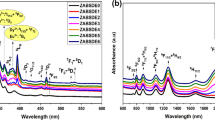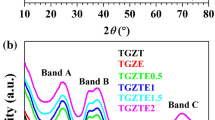Abstract
A spectroscopic analysis of Dy3+, Eu3+ and Dy3+/Eu3+ doped lithium-aluminum-zinc phosphate glasses is carried out based on absorption and photoluminescence spectra and decay time measurements. According to the CIE1931 chromaticity coordinates and correlated color temperature (CCT), neutral white and reddish-orange global emissions were observed in the Dy3+ and Eu3+ singly-doped glasses, respectively, after excitations of Dy3+ at 348 nm and Eu3+ at 393 nm. A high red color purity of 97.2% is achieved in the Eu3+ singly-doped glass excited at 393 nm. Upon Dy3+ excitation at 348 nm, the Dy3+/Eu3+ doped glass showed warm white overall emission, with CCT value of 3629 K. Upon Dy3+ and Eu3+ co-excitations at 362, 381 and 387 nm, the Dy3+/Eu3+ doped glass showed reddish-orange overall emissions, with CCT values in the 1620–2385 K range, depending on the excitation wavelength. In the Dy3+/Eu3+ doped glass excited at 348 nm, the warm white emission was achieved by a non-radiative energy transfer from Dy3+ to Eu3+ with an efficiency and probability of 0.08 and 89.51 s−1, respectively. The dominant mechanism could be through an electric quadrupole–quadrupole interaction, as it is suggested from the Inokuti-Hirayama model. A back non-radiative energy transfer from Eu3+ to Dy3+ is also observed, which could also be mediated by an electric quadrupole–quadrupole interaction. The Eu3+ to Dy3+ energy transfer efficiency and probability being of 0.08 and 30.00 s−1, respectively.








Similar content being viewed by others
References
M.C.S. Reddy, B.A. Rao, M.G. Brik, A.P. Reddy, P.R. Rao, C.K. Jayasankar,·N. Veeraiah, Emission characteristics of Dy3+ ions in lead antimony borate glasses. Appl. Phys. B. 108, 455 (2012)
A. Lira, A. Speghini, E. Camarillo, M. Bettinelli, U. Caldiño, Spectroscopic evaluation of Zn(PO3)2:Dy3+ glass as an active medium for solid state yellow laser. Opt. Mater. 38, 188 (2014)
J.L. Cai, R.Y. Li, C.J. Zhao, S.L. Tie, X. Wan, J.Y. Shen, White light emission and energy transfer in Dy3+/Eu3+ co-doped aluminoborate glass. Opt. Mater. 34, 1112 (2012)
V.R. Bandi, B.K. Grandhe, H.-J. Woo, K. Jang, D.-S. Shin, S.-S. Yi, J.-H. Jeong, Luminescence and energy transfer of Eu3+ or/and Dy3+ co-doped in Sr3AlO4F phosphors with NUV excitation for WLEDs. J. Alloys Compd. 538, 85 (2012)
E. Pavitra, G. Seeta Rama Raju, J.S. Yu, White light emission from Eu3+ co-activated Ca2Gd8Si6O26:Dy3+ nanophosphors by solvothermalsynthesis. Ceram. Int. 39 (2013) 6319.
S. Das, A.A. Reddy, S.S. Babu, G.V. Prakash, Controllable white light emission from Dy3+–Eu3+ co-doped KCaBO3 phosphor. J. Mater. Sci. 46, 7770 (2011)
J. Massera, K. Bourhis, L. Petit, M. Couzi, L. Hupa, M. Hupa, J.J. Videau, T. Cardinal, Effect of the glass composition on the chemical durability of zinc-phosphate-based glasses in aqueous solutions. J. Phys. Chem. Solids 74, 121 (2013)
R.K. Brow Review: the structure of simple phosphate glasses, J. Non-Cryst. Solids 263–264, 1 (2000)
H. Zhong, G. Chen, L. Yao, J. Wang, Y. Yang, R. Zhang, The white light emission properties of Tm3+/Tb3+/Sm3+ triply doped SrO–ZnO–P2O5 glass. J. Non-Cryst. Solids 427, 10 (2015)
S. Li, S. Huang, F. Wu, Y. Yue, Structure and properties of zinc aluminophosphate glasses and those doped with zirconium dioxide. J. Non-Cryst. Solids 419, 45 (2015)
H.-J. Zhong, G.-H. Chen, S.-C. Cui, J.-S. Chen, Y. Yang, C.-R. Zhou, C.-L. Yuan, Luminescence and energy transfer of Tm/Tb/Mn tri-doped phosphate glass for white light-emitting diodes. J. Mater. Sci. 26, 8130 (2015)
C.S. McCamy, Correlated color temperature as an explicit function of chromaticity coordinates. Color. Res. Appl. 17, 142 (1992)
A.N. Meza-Rocha, I. Camarillo, R. Lozada-Morales, U. Caldiño, Reddish-orange and neutral/warm white light emitting phosphors: Eu3+, Dy3+ and Dy3+/Eu3+ in potassium-zinc phosphate glasses. J. Lumin. 183, 341 (2017)
C.R. Kesavulu, C.K. Jayasankar, White light emission in Dy3+-doped lead fluorophosphate glasses. Mater. Chem. Phys. 130, 1078 (2011)
A.N. Meza-Rocha, A. Speghini, M. Bettinelli, U. Caldiño, White light generation through Zn(PO3)2 glass activated with Eu3+ and Dy3+. J. Lumin. 176, 235 (2016)
U. Caldiño, A. Speghini, M. Bettinelli, Optical spectroscopy of zinc metaphosphate glasses activated by Ce3+ and Tb3+ ions. J. Phys. 18, 3499 (2006)
D.A. Rodríguez-Carvajal, A.N. Meza-Rocha, U. Caldiño, R. Lozada-Morales, E. Alvarez, M.E. Zayas, Reddish-orange, neutral and warm white emissions in Eu3+, Dy3+ and Dy3+/Eu3 doped CdO-GeO2-TeO2 glasses. Solid State Sci. 61, 70 (2016)
P. Villanueva-Delgado, K.W. Kramer, R. Valiente, M. de Jong, A. Meijerink, Modeling blue to UV upconversion in β-NaYF4:Tm3+. Phys. Chem. Chem. Phys. 18, 27396 (2016)
U. Caldiño, Energy transfer in CaF2 doped with Ce3+, Eu2+ and Mn2+ ions, J. Phys. 15, 7127 (2003)
T. Nishida, T. Ban, N. Kobayashi, 340–350 nm GaN-free UV-LEDs. Phys. Status Solidi A 200, 106 (2003)
S. Guha, N.A. Bojarczuk, Ultraviolet and violet GaN light emitting diodes on silicon. Appl. Phys. Lett. 72, 415 (1998)
Q. Zeng, P. He, H.B. Liang, M. Gong, Q. Su, Luminescence of Eu3+-activated tetra-molybdate red phosphors and their application in near-UV InGaN-based LEDs. Mater. Chem. Phys. 118, 76 (2009)
Acknowledgements
A.N. Meza-Rocha and R. Lozada-Morales thank Cátedras CONACyT (Grant No. 2801). This work was supported by the CONACYT-CNR bilateral agreement under Project Contract 173855. Authors appreciate the technical support from Laboratorio Central-IFUAP.
Author information
Authors and Affiliations
Corresponding author
Rights and permissions
About this article
Cite this article
Meza-Rocha, A.N., Speghini, A., Franchini, J. et al. Multicolor emission in lithium-aluminum-zinc phosphate glasses activated with Dy3+, Eu3+ and Dy3+/Eu3+ . J Mater Sci: Mater Electron 28, 10564–10572 (2017). https://doi.org/10.1007/s10854-017-6830-9
Received:
Accepted:
Published:
Issue Date:
DOI: https://doi.org/10.1007/s10854-017-6830-9




